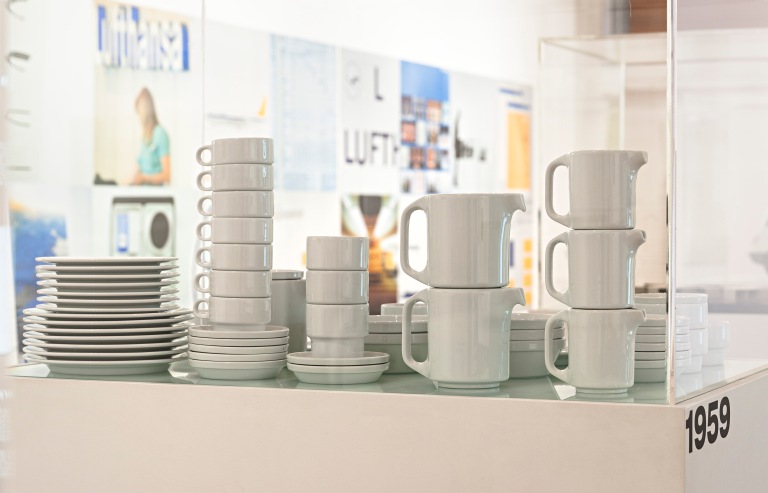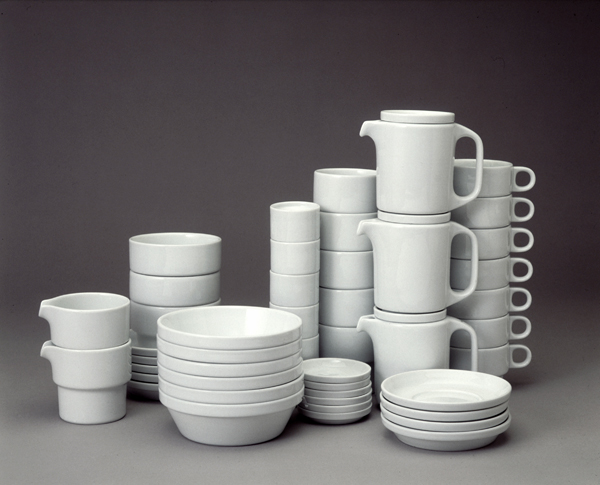The first thing that many people express when they see the Stackable Tableware TC 100 in the current RMIT Gallery exhibition ‘Ulm School of Design’ (1-30 August 2014) is surprise. That’s because such a ubiquitous design looks out of place in an art gallery. After all, they think, didn’t we just drink out of one of those white catering cups the other day at a work event?
In fact,soon after its launch in 1959, the TC 100 Stackable Tableware was deemed so extraordinary that it was snapped up by the Museum of Modern Art in New York as part of its collection. It has won a number of awards, and is ubiquitous because it has been in serial production since 1961. It is important in design because it integrates production processes, transportation, and storage issues at the design stage.
The TC 100 started life as a diploma project at the Ulm School of Design, and was the brainchild of student Hans (Nick) Roericht. All pieces of the tableware with the same diameter are stackable. The individual stacks are stable thanks to a double cylinder construction which no designer had used before. A sloping side with thickened rim made it possible for the saucers and tureens to be stackable – these characteristics resulted in a unique product appearance.
In his RMIT Gallery podcast, Dr. Martin Mäntele, director of the HfG-Archive, explains that as the Ulm model is based on technology and design, the product designer is no longer a lofty artist but is involved in the whole production process.
“That means that [the designer] does not only have to know about aesthetics, but also he has to know how a factory works. This brings me back to the library [an important resource within the school] because we also find many technical books within the library, which were available to the students. My favourite is a brochure about how crockery dries in industrial dishwashers.”
“We all know this problem of opening the dishwasher, and there’s always one item you have to give an extra wipe with your tea towel. And, of course, you have to think about this problem too when you are designing tableware, because if you try to sell this to somebody running a restaurant, and that person sees that his people have to dry the cups or whatever for an extra minute, they just lose too much time, so they won’t buy this particular design, and so, it will not be a successful design. And so that’s why designers have to be so precise about everything with the design.
“The example of the Stackable Tableware TC 100 shows that you can’t resolve problems like this just by intuition alone, because you might not think about it, because you might instead be meditating about a perfect shape. Good design however doesn’t come from intuition.”
At one of the recent guided tours at RMIT Gallery the question was asked – just how are the underside of the cups and plates designed to ensure that they come out of the industrial dishwasher without water clinging to them?
When we forwarded this query onto Dr. Mäntele, who had returned to Germany, he took it the question back to the source – in fact, to the original designer Hans (Nick) Roericht. A lunchtime discussion at Ulm ensured, and this was the reply:
Dr. Mäntele writes: “We found that the underside of the cups and the saucers (or plates) are quite different. The cups have a rather shallow underside just like the large serving bowls. However the saucers and plates look different and are comparatively deep.”
“We concluded that this has also to do with how you have to place the item into the dish washer. Naturally the cup goes in upside down whereas the plates or saucers are placed more or less vertically, resulting in the water running down and not collecting puddles of any kind or size. The shallowness of the cups’ underside does not collect so much water that it would not dry anyway.”
“The stackability is the main issue about the TC 100. That’s why the exhibition displays different stacks. Again it was an absolutely new concept that pitchers and tea and coffee pots could be stacked. Older models had a more stout if not even bulgy shape which could not be stacked and also not be stored in a compact manner.
 “So in the vitrine we have 1, 2, 3, 4, 5, 6, 7, stacks – one cup on top of the other – but we could go even higher. Just don’t try this with any cups you have at home, you won’t be able to do it usually, because again, the handle has to be at a certain point of the cup in order to make this possible.”
“So in the vitrine we have 1, 2, 3, 4, 5, 6, 7, stacks – one cup on top of the other – but we could go even higher. Just don’t try this with any cups you have at home, you won’t be able to do it usually, because again, the handle has to be at a certain point of the cup in order to make this possible.”
It wasn’t just stackability that was the breakthrough – the ‘C’ in the nifty name ‘TC 100’ stands for ‘compact’. The tableware can be stored in very tight spaces too, because all the elements are within a grid system.
“Hans Nick Roericht told me that it was a big diploma project because he designed more than 30 pieces, because in those days they tried to have many different pieces for different functions within this field.”
“Design students just can’t design this by intuition, they have to know about what is happening in the factory and Hans (Nick) Roericht went to the factory, which is in the Bavarian area, close to the Czech border where the large china factories are situated in Germany.
 “Even though the cylinder as a basic idea in the tableware design, if we look at the finished product we find that the lower part is not a cylinder any more but has a slight slope. And this is simply a necessity in order to remove the finished product from the form in the factory. And technical engineers will tell you that this particular slope has to be at least a 2 per cent degree, the slope has to be 2 per cent slope.”
“Even though the cylinder as a basic idea in the tableware design, if we look at the finished product we find that the lower part is not a cylinder any more but has a slight slope. And this is simply a necessity in order to remove the finished product from the form in the factory. And technical engineers will tell you that this particular slope has to be at least a 2 per cent degree, the slope has to be 2 per cent slope.”
So – there you have it. The next time you are at a catered event, ponder the origins of the TC 100 and its significance in modern design. However, chances are that the white cup you are sipping out of isn’t an authentic TC 100 and the coffee will spill into the saucer, and you should not try to do a 20 height stack if it is your task to clean the tables.
But if you are lucky enough to be able to use one of the original products in the TC 100 series – would you notice the difference of good design? Indeed you would. Dr. Mäntele says that he knows from experience that the milk jugs don’t drip and splatter all over the table.
Want further insights into the Ulm School of Design? Here is Dr. Martin Mäntele, director of the HfG-Archive, speaking at the RMIT Gallery exhibition:





One thought on “Ulm School of Design Insight – Stackable Tableware TC 100”